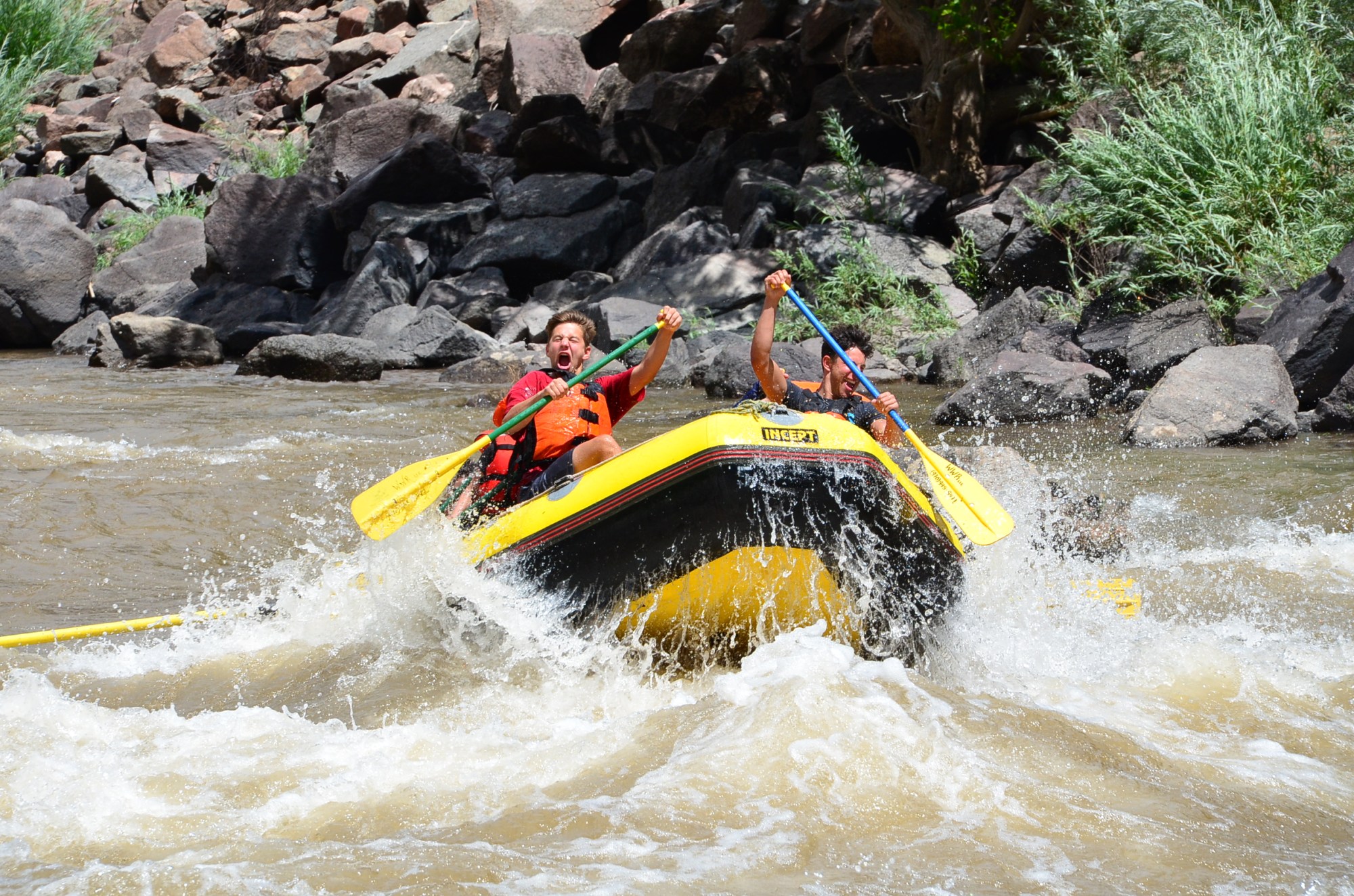Rocky Mountain Rafts Review: Phat Cat Rafts

As the owner of a rafting company in Colorado I have access to quite a few different rafts. My company owns about 60 rafts and has access to every major brand. Getting to try out lots of brands and sizes is a big perk of being in he industry. And I boat a lot. I get at least 100 days per year, none of those guiding. So the question I want to answer is: which raft do I take out personally?
Answer:The Rocky Mountain Rafts Phat Cat
Let’s get into why and where this craft excels and what it doesn’t do as well, as well as why you might want to buy it.
Weight
Rocky Mountain Rafts are made from high denier PVC. All seams are welded, not glued. While this construction method makes some of their larger boats a bit heavy, the Phat Cat simply isn’t big enough to be impacted. It’s still a light boat. The manufacturer’s website states the boat weighs 52lbs. This would be sweet because one might reason that if you could just cut a few superfluous D-rings off you might get it down under the 50lbs airline checkable weight limit. International self support trips here I come! Right? No. With just rubber, no perimeter line or netting, I mined weighed out to 65lbs.
However, this boat is still plenty light. You can shoulder carry it solo like a creek boat, you can car top it inflated solo, two people can easily carry it through the woods to that semi-legal put-in you prefer on your favorite home stretch (think Zero on the Ark).
Durability
I’ve owned mine for 3 years. It lives at the boathouse where anyone who wants it is free to take it anytime. With 60+ raft guides, it gets out a lot. And we take it on small water. Mine’s been to creeks with 250cfs in them, it’s been dragged, pinned, boofed, surfed with 600lbs of man meat on it, had 800lbs of rafts stacked on top of it, left over inflated in the sun, driven over mountain passes fully inflated and generally abused with no consideration to resale value or potential repairs. After all that there’s not a scratch on it. No holes, no leaks, no repairs, not even any 303. This thing is bomber. Considering the above commentary on weight should it have been built lighter? Absolutely not.
Storage
The big drawback of PVC construction is that it cannot be stored rolled up for long periods of time. The fabric will crease and you’ll get little white weak spots on the material, like if you bend a plastic toy. RMR recommends you store the boat 50% inflated. If you can in any way arrange to store it flat, you’re good to go. This is a big drawback for some people, and overall, the biggest drawback of any brand building in PVCPricing
For $1,400 you can’t go wrong. The common sentiment here is not whether that’s cheap enough, but if it’s so cheap that it must be crap. Not the case. The Phat Cat and the RMR brand in general are where value and affordability meet. Resale value tends to be excellent as well. Buy one new and sell it in 3 years and it’s probably only going to cost you $150/year to own this thing. I take a bigger loss on kayaks.
Finer Points
You get in some boats and it’s immediately apparent that the designer never got in the darn thing. The knee height is wrong, the thwarts are awkwardly sized or in the wrong place, and there’s never a D-ring where you need it. This is not the case in the Phat Cat. This boat feels like it’s been through 5 design edits before being puhed out to the masses. The knee height is perfect for those between 5’3” and 6’2”. The foot cups seemed off at first for me, but after a week, I saw that the designers were right and I was wrong. The tube size is vastly superior to its predecessor, the Hyside Shredder. The kick is legendary. Those big pointy ends are nearly impossible to bury while surfing or boofing a ledge (or failing to do so!) Then there’s the details. We run one 20’ NRS cam strap as a perimeter line. This is a pretty nice design feature as you’ve got a 20’ tether line if you need it, a cam strap to roll it up with and the perfect length perimeter line in one item (there’s about 1” to spare the way I set it up). It’s easy to stash one or two spare paddles outboard under the perimeter. A certain amount of pretension on this cam strap seems to lend a bit of extra rigidity to the boat as well. Finally, when rolled up it fits easily into most compact car’s trunks or back seats. She’ll ride shotgun nicely.
The only criticism is the drain holes. There are three drain holes in the aft end of the cockpit floor. They would be adequate for draining in most conditions, however almost every paddler braces their back foot directly over these holes. This completely blocks them and causes undue water buildup in a boat that is very weight sensitive. It’s to the point that experienced paddlers will deliberately take time to move their foot out of position between rapids in order to facilitate more rapid draining. These drain holes are not at the bottom of the floor either, so you can’t easily get that last little bit of water out on smaller rapids either. My recommended design fix to RMR for this is to place one big hole in the middle of the cockpit floor ringed and crossed with sewn in webbing. Maybe we’ll see this on a future version.
Buy the right boat for the rivers you run
(Almost) every raft has some niche in which it fits perfectly. The ubiquitous 14’ 3 thwart self bailing raft does almost everything well, but nothing perfect. It can R2 (R2 = 2 people with paddles in a raft) big water, carry 6 people for a “drift and drink” type float, and be framed for fishing or multidays. Small boats like an Aire Puma or RMR Cloud 9 can shred tiny creeks and are easily carried or car topped by two people. 16’+ big rigs carry big gear loads with ease, and have room for the wife and dog. And who doesn’t want to paddle a Jack’s Plastic 18’ framed cat boat on some desert canyon? So let’s make sure if you get a Phat Cat you’ve got it for the right reasons.
So, what do we run the Phat Cat on? The hardest water we dare, plain and simple. In class IV and V conditions this thing is your best friend. In creeks, steeps, waterfalls, big water class V, R1 or R2 this little guy makes hard water easy. Want to keep up with your hard core creek boater friends? You can do it in this. Take it to the play park, it surfs like a champ. You can get on a wave, get stable, and start jumping all over this thing. You’ll get more cheers than Dane Jackson.
We’ve sent this thing down area classics like: Slaughterhouse, Narrows of the Crystal, Pine Creek / #s of the Ark, Gilman Gorge of the Eagle, Crystal Mill Falls, Lawson section of Clear Creek, an attempted run on Meatgrinder of the Crystal, Barrel Springs of the Colorado, Gore Canyon, Castle Creek and many more class IV/V runs. To date I’ve seen two flips over 3 seasons on all those runs among the three Phat Cats owned by myself and other guides at our company. That’s a lot of miles with very little carnage.
Looking for the best raft to R1 or R2 hard, scary water? This is the best choice, hands down, no question.
What’s it not good for?
Despite this so far glowing review, there is quite a bit that this boat is not great at. Want to take a few friends out on class II/III water with some beers? You can’t. Want to chill on your local class III section and R1? You’ll be bored to tears, this boat is just too capable. Want to do a multiday with raft support? The wind will kill you, you’ll end up a passenger on a proper raft with your precious toy being towed along behind.
There are other drawbacks too. This thing can’t take much of a load before the cross tubes start dragging in the water, making your cataraft more of a poorly designed regular raft. It gets slow and water invades the floor. The weight limit seems to be about 400lbs. Above that you’ll be dragging. This means getting the RMR Phat Cat specific frame is nearly useless. We made that mistake. I’d say we’ve put the frame to water 5 times in 3 years, so yeah. You’re so close to the weight limit between yourself and the frame, you’ve got no usable payload for multiday gear. So solo or self support mutlidays with the frame are out too, bummer I know. Also, if you’re bigger and your friend is too, it might not be great for you.
Combined, this makes the boat a one trick pony, for better or worse. Like any precision instrument, when used for the express purpose of running hard water R1 or R2, it’s absolutely the best tool for the job. For pretty much anything else, from riding with more than one friend, to multiday, to easy water play time, it’s not great and there are better choices. That lack of versatility is a big criticism. Folks buying only one boat had better like what this can do. If you want something that can do most of the hard water on the list, plus multiday for two, “drink and drift” with 6, or get framed for fishing – get a 12.5’-14’ raft instead, preferably in hypalon for easy storage and life long ownership.
By Erik Larsson, Owner of Whitewater Rafting, LLC
